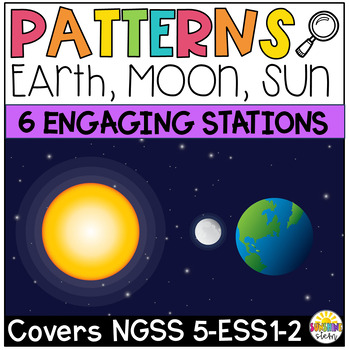Patterns of the Earth, Moon and Stars Stations {NGSS Aligned}
- PDF
- Google Apps™
- Easel Activity

What educators are saying
Also included in
- Two amazing station activities with six stations each! Informational text at each station sharpens students reading skills while engaging in scientific ideas and phenomena. Stations align with NGSS standards for Earth and Human Activities and Earth's Place in the Universe. Earth and Human ActivityPrice $6.50Original Price $8.00Save $1.50
- This bundle includes three amazing resources that support both Earth's Place in the Universe and Engineering Design! Increase student engagement with fun, hands-on activities and projects as you facilitate and watch the excitement! ⭐ Resource One - Patterns of Earth, Moon and Sun Stations Six engagPrice $10.50Original Price $13.00Save $2.50
- Hit three NGSS standards in one bundle! 5-LS2 Ecosystems: Interactions, Energy, and Dynamics 5-ESS1-2 Earth's Place in the Universe 5-ESS3 Earth and Human ActivityAll three station resources are designed for collaborative, student centered learning in an engaging and fun way! Very little prep or mPrice $8.00Original Price $10.25Save $2.25
Description
⭐Now with a Google Slide option!
Six engaging stations - take your students on a journey to learn about the predictable patterns of the earth, moon, and stars! Each station has an interesting informational text to give students background information and how these patterns have been used since ancient times. After students read the informational text and observe the pictures, illustrations, and/or graphs they apply what they have learned by answering thought-provoking questions, creating graphs from pattern data, exploring concepts using models, and even becoming treasure-seeking pirates using the stars as direction finders to locate the booty! Very little prep and a few easy classroom materials make this activity an excellent choice to engage students in science concepts while sharpening their informational text reading skills.
Now with Quick Check Quiz
Station one – Star trails. Students read about stars’ trails before exploring the differences between the North Star and other stars as the earth rotates. Students then become treasure-seeking pirates using the North Star to navigate the seas to the lost treasure!
Station Two – Reasons for the seasons! Students learn that seasons exist because of the earth’s tilt rather than distance to the sun! After the reading, students complete a matching activity with diagrams and the different seasons.
Station Three – Hours of Daylight! Students learn why there are more daylight hours in the summer than in the winter before completing a bar graph using data of average hours of sunlight per month.
Station Four – The Changing Constellations. Whether near or far, stars make patterns in our night sky that have captured people's imaginations for centuries. Students analyze constellation maps of two different seasons to note the similarities and differences. Finally, students create their very own constellation using a group of stars.
Station five – Patterns of Shadows. Students learn about the length of shadows in relation to the different seasons. Students also learn how ancient people developed a way to tell time using shadows with a sundial. Students sketch shadows of trees in two different seasons before applying their knowledge of sun and earth patterns by creating a simple working sundial.
Station Six – Tides. Students learn about the daily effect of the moon on earth’s waters by reading about tides. Students then create a line graph using tide data before analyzing to find the pattern and making a prediction of tides in the future.
Also included is an easy grade rubric, a station setup guide with simple classroom materials to use at each station, and a full answer key!
This product is aligned with NGSS, Earth's Place in the Universe 5-ESS1-2 -
Represent data in graphical displays to reveal patterns of daily changes in length and direction of shadows, day and night, and the seasonal appearance of some stars in the night sky.









